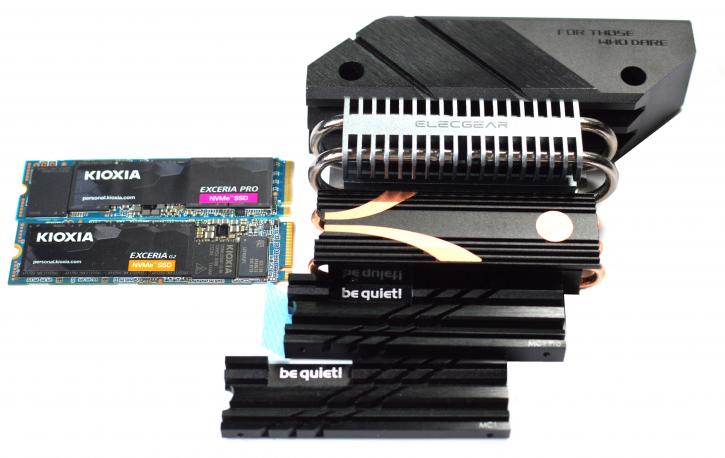Introduction
Guru3D NVMe Thermal Test - heatsink vs. performance
Does temperature influence performance?
Introduction
We conducted two Thermal Paste roundups, the first in 2019 and the second in 2021. Why not try something else and investigate the temperature influence of other PC components outside the CPU/GPU? Perhaps it would be worthwhile to test the radiator's slash heatsink impact on NVMe drive performance. What's the deal you wonder? Perhaps let me present some background first. The SSDs overall are much cheaper compared to the previous years. Also, the 2.5” SATA drives (which already were a revolution in the market compared to traditional HDDs, 4-5x faster – having about 500 MB/s transfer, with a much better access time) are becoming less popular because the PCI Express-based NVMe SSDs took over their role. The m.2 drives are compact (8 x 2.2 cm); you need to only put them in the appropriate slot in the motherboard, without needing to connect the power and data cables, as before for the SATA standard. The NVMe SSDs prices are not significantly different from the 2.5” (especially for the PCIe 3.0 compatible drives), so if you also consider a better performance (with up to 3.5 GB/s for PCIe 3.0 and 7.0 GB/s for PCIe 4.0 standard, so theoretically up to 7-14x faster) – it’s no biggie which one is a much more reasonable option.
But not all is better. You get a faster drive; on the other side, it won’t be as cool as the 2.5” SATA drive due to the storage density. The NVMe drives can reach and even exceed the temperatures of 80°C. The intended operating range for most NVMe SSDs is between 0°C and 70°C. Quite many manufacturers don’t provide any additional cooling. Ok, but what can be the effect of such temperatures (except heating the chassis interior)? It can affect (in the longer term) the data integrity and longevity, but to measure that effect – it would take much time (in years), and it would have to be done on at least a couple of drives to have a good test sample. So what else? It does affect the drive performance, and the primary goal of this test is to check the effect. How were we going to do it? By running some benchmarks and doing a real-life scenario by copying the files.
We have used two different NVMe drives:
- Kioxia Exceria Pro 2 TB, which has been already reviewed in a separate test by Hilbert (PCIe Gen4 x4 drive, with up to 7,300 MB/s Read Performance)
- Kioxia Exceria G2 1 TB (PCIe Gen3 x4 drive, with up to 2,100 MB/s Read Performance)
Ok, these SSDs are the subjects. But what will be the cooling options used for the test?
- The raw NVMe drive without heatsink
- Asus Maximus Z690 Apex M.2 heatsink,
- be quiet! MC1 M.2 heatsink,
- be quiet! MC1 Pro M.2 heatsink
- Sabrent M.2 2280 SSD Rocket Heatsink (SB-HTSK)
- ElecGear EL-80P Heatsink
Our test rig is based on the latest Intel Core i9 12900K (Alder Lake) platform. It shouldn’t cause any performance bottlenecks since the Z690 supports the PCIe 4.0 standard, and in the case of Asus Maximus Z690 Apex, it’s even possible to plug in the PCIe 5.0 drive (in an adapter). Ok, let’s get to it.


